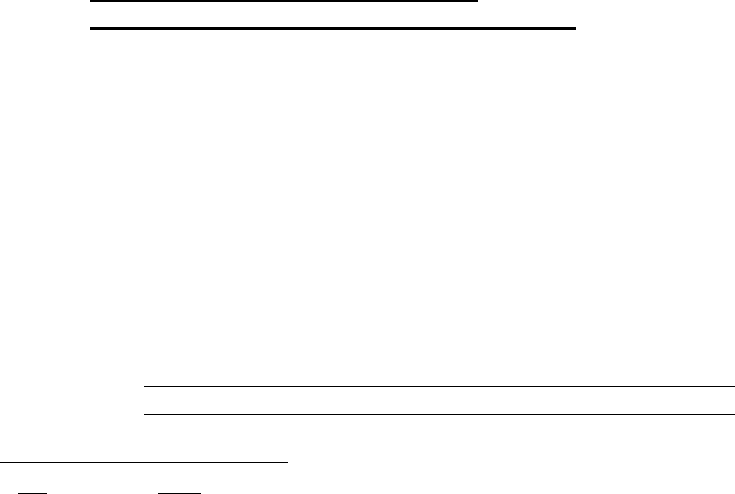
LV1 327395v2 05/23/05
1
Navigating New Jersey’s
New Home Warranty and Builders’ Registration Act:
A Primer
By Thomas Daniel McCloskey, Esq.
Fox Rothschild LLP
The New Jersey New Home Warranty and Builders’ Registration Act, and
regulatory scheme promulgated thereunder (collectively, the “Act”),
1
establishes a program
that aspires to provide “unique protection” to homeowners by requiring that newly
constructed homes conform with certain construction and quality standards and by further
providing buyers of new homes with insurance-backed warranty protection in the event
such standards are not met.
2
Under the Act, no builder may engage in the business of
building new homes unless he is registered with the New Jersey Department of
Community Affairs (“DCA”) and furnishes a new home warranty to an owner by either
participating in the New Home Warranty Security Fund or an approved alternate new
home warranty security program.
3
1
N.J.S.A. 46:3B-1, et seq. ; N.J.A.C. 5:25-1, et seq.
2
N.J.S.A. 46:3B-7.1.
3
N.J.S.A. 46:3B-5. Under the Act, a “builder” is defined to mean “any individual corporation, partnership
or other business organization engaged in the construction of new home” [N.J.S.A. 46:3B-2f]; a “new home”
is defined to mean “any dwelling unit not previously occupied, excluding dwelling units constructed solely
for lease” [N.J.S.A. 46:3B-2d]; and a new home “owner” is defined to mean “any person for whom the new
home is built or to whom the home is sold for occupation by him or his family as a home and his successors
in title to the home or mortgagee in possession”, and specifically defined not to mean “any development
company, association or subsidiary company of the builder or any person or organization to whom the home
may be sold or otherwise conveyed by the builder for subsequent resale, letting or other purpose” [N.J.S.A.
46:3B-2e]. Moreover, a person (or his engineer/architect and attorney) who constructs a home for his own
personal occupancy is not required to register as a builder; a subsequent resale of the new home to a
purchaser who is not the original builder/owner must contain a notification at the time of the transfer or
closing that the homes does not carry a warranty [see Glaum v. Bureau of Construction Code Enforcement,
221 N.J.Super. 79 (App. Div. 1987]; and, a person is not permitted to construct a new home for his own use
more often than once each five years without being registered as a builder [N.J.A.C. 5:25-2.1(d)].

LV1 327395v2 05/23/05
2
By regulation, the warranty is required to include “standards for construction and of
quality for the structural elements and components of a new home with an indication,
where appropriate, of what degree of noncompliance with such standards shall constitute a
defect.”
4
Both the Act, and the warranty it requires, contain a procedural “election of
remedy” mechanism for homeowners aggrieved by defects in new home construction
which gives the homeowner the option to seek remedy and recourse for defect claims by
electing a binding arbitration process, in lieu of judicial relief or remedy in the courts,
through the assertion of claims against the warranty -- the salutary purpose of which is to
provide a “prompt, convenient and cost-saving means of resolving disputes concerning
construction defects.”
5
In reality, the Act, when applied or availed of, can be a veritable minefield of
controversy, laced with trip-wires and booby traps for the unwary, that can often pit both
the homeowner and builder against each other in a seemingly interminable, hopeless
quagmire of irreconcilable differences – thereby thwarting the stated purposes and policy
the Act purports to attain. It is the intent of this writing to aid the homeowner, builder and
their professionals alike in navigating through the unintended complexities of this now
dispute-provocative area of the law.
4
N.J.S.A. 46:3B-3a. In addition, the warranty is applicable to new owner-occupied two-family homes to the
same extent as to one-family homes; and, in the event of a mixed residential/nonresidential use, the warranty
applies only to the residential portion unless a defect in the nonresidential portion is or will be the proximate
cause of a residential portion defect. N.J.A.C. 5:25-3.1(e) & (f).
5
N.J.S.A. 46:3B-9; see also Konieczny v. Micciche, 305 N.J.Super. 375, 382 (App. Div. 1997).

LV1 327395v2 05/23/05
3
A. The Warranty.
The warranty required by the Act that is furnished by builders to new home owners
accords coverage and protection against defects falling within three (3) time-sensitive
categories:
(1) One (1)-year from and after the warranty date the dwelling shall be free from
defects caused by faulty workmanship and defective materials due to noncompliance with
the building standards as approved by the DCA Commissioner, except as set forth in (2)
and (3) below;
(2) Two (2)-years from and after the warranty date the dwelling shall be free from
defects caused by faulty installation of plumbing, electrical, heating and cooling delivery
systems; however, in the case of appliances, no warranty shall exceed the length and scope
of the warranty offered by the manufacturer; and
(3) Ten (10)-years from and after the warranty date for major construction defects
as defined in the Act.
6
The typical warranty delivered by builders to new homeowners at settlement or
closing of title to the new home will usually be accompanied by a detailed warranty
manual or booklet which describes in detail the scope and nature of the warranty coverage.
The booklet will specifically define the coverage, the builder-warrantor’s coverage
obligations, the nature and types of deficiencies deemed covered under the applicable
6
N.J.S.A. 46:3B-3b(1), (2) & (3). “Warranty date” is defined to mean “the first occupation or settlement
date, whichever is sooner.” [N.J.S.A 46:3B-2h]. “Major construction defect” is defined to mean “any
actual damage to the load bearing portion of the home including damage due to subsidence, expansion or
lateral movement of the soil (excluding movement caused by flood or earthquake) which affects its load
bearing function and which vitally affects or is imminently likely to vitally affect the use of the home for
residential purposes” [N.J.S.A. 46:3B-2g].
LV1 327395v2 05/23/05
4
coverage period, coverage limitations, coverage exclusions, and procedures for the making,
processing and arbitration of defect claims.
Importantly, the warranty manual will set forth a detailed set of performance
standards by which either the builder or the warranty arbitrator can evaluate and, where
applicable, even measure whether or when a claimed defect meets, exceeds or fails to meet
the minimum standards required for warranty compliance. The performance standards
contained in the typical warranty manual will set minimum standards which prescribe the
level for quality of materials and performance in workmanship for the construction of the
warranted new home. To the extent that detailed minimum performance standards for
construction have not been specifically enumerated the builder-warrantor usually warrants
to construct the home in accordance with good industry practice which assures quality of
materials and workmanship. Thus, the validity of a homeowner’s claim for defect for
which a standard has not been enumerated in the warranty manual will likely be
determined, in any conciliation or arbitration mechanism provided for claim resolution in
the warranty, on the basis of good industry practice which assures quality of materials and
workmanship.
Furthermore, the typical warranty booklet or manual in its “performance standards”
section will detail specific items that commonly arise or recur in the new home
construction process and standards for defect evaluation with each separate area of
coverage. Some warranty manuals go so far as to identify items of construction, describe
the nature or type of deficiency or defect that does or may arise, describe the performance
standard by which to judge or evaluate the item for warranty compliance or noncompliance

LV1 327395v2 05/23/05
5
as well as to define what the builder-warrantor’s obligations are or should be to effect the
necessary repair or replacement to achieve warranty compliance. For example, a typical
warranty manual will contain rules concerning:
“First year only” coverage involving items of construction where defects may arise
concerning site work (e.g., grading, drainage, landscaping); concrete (basement or
foundation walls, garage floors, etc.); masonry (block, brick or stone); carpentry
(rough carpentry, framing, floors, finishes, etc.); thermal and moisture protection
(waterproofing, leaks, insulation, louvers and vents, exterior siding, shingles, etc.);
roofing and roofing systems; sealants (water or air leaks, caulking, caulk joints,
interior and exterior, etc.); sheet metal (e.g., gutters, downspouts); interior and
exterior doors, garage doors (attached); windows (wood, plastic or metal);
hardware; storm doors, window and screens; weather-stripping and seals; glass and
glazing; finishes (e.g., lath and plaster, gypsum or sheetrock wallboard); hard
surface flooring (flagstone, marble, quarry tile, slate, ceramic, etc.); resilient
flooring (e.g., linoleum); plywood wall covering, finished wood flooring; other
finishes such as painting, wall covering, carpeting; and specialty items such as
fireplaces, built-in sauna and steam bath units; and kitchen cabinets and vanities.
“First or second year” coverage involving items of construction where defects may
arise concerning mechanical systems. Such systems would include septic tanks (if
applicable); plumbing; water supply; heating and air conditioning; electrical
systems (conductors, switches, receptacles, service and distribution, etc.).
Year “2 through 10” coverage for “major construction defect(s)” or “major
structural defect(s) involving items of construction where defects may arise or
manifest themselves in years 2-10 from and after the “warranty date”. Here, the
typical warranty manual will attempt to be even more specific in its definitional
criteria by describing, for coverage purposes (i) what a “major structural defect” is
or means, e.g., the failure of the load-bearing portion of a new home (itself
typically defined to mean the framing members and structural elements that
transmit both dead and live loads of the home to the supporting ground, e.g., roof
rafters and trusses, ceiling and floor joists, bearing partitions, supporting beams,
columns, basement and foundation walls and footings); and (ii) what warranty or
accepted “tolerances” of enumerated structural elements – e.g., arches, floor
systems, foundations, lintels and headers, roof framing, structural beams and
girders, structural columns (concrete, masonry, steel or wood), load bearing walls
and partitions, roof and floor sheathing – which, if not met, will qualify the claimed
defect as a structural failure for which coverage and remedy is appropriate.
7
7
Here, the warranty manual will enumerate minimally acceptable “tolerances”, or measurements, as
established under either the New Jersey Uniform Construction Code (“UCC’) or generally accepted industry
practice, by which to gauge or determine if a structural element has met, exceeded or fallen below that which

LV1 327395v2 05/23/05
6
In respect of the latter, buried in the proverbial “fine-print” of the typical warranty
manual will be a series of exclusions from coverage. Thus, the warranty may very well
exclude as “major structural defects” items such as (i) changes by the home owner to the
established grade lines affecting basement and foundation walls; (ii) movement or
settlement caused by flood or earthquake; (iii) damages caused by additions or alterations
to the home performed by other than the original builder; (iv) actual or resultant damage
caused by lightning, tornado, unnatural high winds or hurricanes; (v) improper loading
over and above design criteria for which that portion of the home was intended; (vi)
resultant structural damage due to fire; (vii) changes in the water level which is caused by
new development in the immediate area or can be traced to an act of either the home owner
or nature; (viii) water seepage in basements or crawlspaces after the first year of coverage;
or (ix) more generally, where the defect may exist but does not render the home
uninhabitable, it is of such a nature that it further does not affect its load bearing function
nor vitally affects the use of the home for residential purposes.
More general exclusions may also be provided for any one of the three (3) time-
sensitive categories of defect coverage where any damage or defect is caused or made
worse by certain described activities or conduct, e.g., without limitation: (i) negligent or
is deemed an acceptable “tolerance” and thus whether it constitutes a defect or failure for which repair,
replacement or remedy is required. Cracks or deflections in walls, foundations, flooring, roofs, structural
beams or other support structures are actually measured in the field, and if determined to be greater than or
outside of a defined unit of measurement (e.g., deflection of 1 inch in 15 feet for floor joists, cracks of 1/8
inch in width or ¼ inch in 30 inches in concrete beams, a deflection of ½ inch in 8 feet for steel beams, a bow
of ½ inch in 8 feet or out-of-plumb ¼ inch in 12 inches measured from the base of concrete columns, and so
on), such a “failure” would be deemed a “major construction defect” for coverage purposes. Normally, the
UCC-permitted “tolerances” that are in effect on the date in which the construction permit was issued for the
home in question will be the benchmark for warranty coverage evaluation purposes. And, in the typical
warranty, insofar as “major construction” or “major structural” defects are concerned, to be eligible for
coverage the claimed defect does not have to render the home uninhabitable; however, it must be of such a
serious nature that it “vitally affects or is imminently likely to vitally affect use of the home for residential
purposes” (see N.J.S.A. 46:3B-2g).

LV1 327395v2 05/23/05
7
improper maintenance by the home owner or any one other than the builder-warrantor, its
employees, agents or subcontractors; (ii) failure by the home owner or any one other than
the builder-warrantor, its employees, agents or subcontractors to comply with warranty
requirements of manufacturers of appliances, fixtures and items of equipment; (iii) failure
of the home owner to give notice to the builder-warrantor or it warranty insurer of any
defects, typically not later than thirty (30) days after the applicable warranty coverage
period for the claimed defect has expired; (iv) changes of the grading of the ground around
the new home by the new home owner or anyone other than the builder-warrantor, its
employees, agents or subcontractors; (v) failure on the part of the new home owner to take
timely action in emergent case to minimize any loss or damage; (vi) any defect in, or
caused by, materials or work supplied by the new home owner or anyone other than the
builder-warrantor, its employees, agents or subcontractors; (vii) normal wear and tear or
normal deterioration in accordance with normal industry standards; (viii) accidental loss or
damage from acts of nature (e.g., fire, explosion, radon gas, smoke, water escape, changes
which were not reasonably foreseeable in the level of the underground water table, glass
breakage, windstorm, hail, lightning, fallen trees, aircraft, vehicles, flood, earthquake, or
insect damage); (ix) any loss or damage which arises while the home is being used
primarily for non-residential purposes; (x) changes, alterations or additions made to the
home by the new home owner or anyone other than the builder-warrantor, its employees,
agents or subcontractors after initial occupancy, except for those performed by the builder-
warrantor in accordance with its obligations under the warranty; (xi) any materials and/or
workmanship furnished and installed that does not comply with the specifications in the

LV1 327395v2 05/23/05
8
purchase-sale agreement or contract with the builder which is not defective; (xii)
consequential damages to personal property; or (xiii) other exclusions that are included in
the “performance standards” section of the warranty manual.
Clearly, new home owners and builders should seek and consult their counsel if, as
or when encountering or confronted with a construction defect or defect claim and, for the
reasons to be outlined infra, well before electing or deploying remedy options (and, as
applicable, defenses) accorded by the Act and/or available under the warranty.
B. The New Home Warranty Program.
As noted, every builder engaged in the construction of new homes must be
registered with the DCA (through its Division of Codes and Standards, Bureau of
Homeowner Protection/New Home Warranty Program), and every corporation, partnership
or business organization must have a stockholder, director, officer, partner or employee as
a registered builder.
8
The certificate of registration is valid for two (2) years and may be
renewed for an additional two (2) years.
9
Any builder who fails to register is subject to,
inter alia, a statutory penalty of $2,000 for each offense.
10
Under the Act, builders of new homes must participate in a new home warranty
plan – either the State plan, or an approved, alternate private warranty security plan or
program. In addition to authorizing warranty coverage through approved alternate private
insurance programs,
11
the Act requires that a new home warranty security fund be
8
N.J.A.C. 5:25-2.2.
9
N.J.S.A. 46:3B-5.
10
N.J.A.C. 5:25-2.6.
11
N.J.S.A. 46:3B-8.

LV1 327395v2 05/23/05
9
maintained by the State Treasurer and administered by the DCA Commissioner on behalf
of the buyers of new homes.
12
Moneys payable to the fund are solely for the purpose of
paying proven claims, providing reasonable reserves, including appropriate forms of
reinsurance, and covering the costs of program administration.
13
The premiums, fees and
other charges assessed builders as a condition of DCA registration are solely for the
protection of the buyers of new homes enrolled in the new home warranty security fund
program.
The DCA Commissioner also is authorized and directed to review and approve
alternate new home warranty security programs which provide for payment of claims
against builders for defects covered under the new home warranty and financial security
adequate to cover the total amount of claims that may be reasonably anticipated against
participating builders at least equivalent to that provided by the new home warranty
security fund.
14
The DCA Commissioner is responsible for reviewing and approving
private new home warranty security programs, and such entails the review and approval of
all private plan documents.
15
As part of an approved, private alternate warranty plan, home builders expressly
warrant the materials they use and their workmanship. Participating builders issue a
“Warranty” or “Limited Warranty” to the home owner, and the warranty will set forth the
three main coverage components. As detailed in Section A, supra, for a period of ten (10)
12
N.J.S.A. 46:3B-7.1b.
13
N.J.S.A. 46:3B-7.1c.
14
N.J.S.A. 46:3B-8.
15
Id.

LV1 327395v2 05/23/05
10
years the builder warrants that defined structural elements (e.g., foundations, load-bearing
walls, etc.) will perform in accordance with certain express and/or acceptable “tolerances”.
In addition, during the first year of the warranty, the builder warrants that the home’s
construction and workmanship will conform to certain specified “performance standards”,
and during the first two (2) years of the warranty the builder also warrants that identified
mechanical systems will conform to express “performance standards”.
Most new home warranties issued by builders to their new home owner-buyers at
closing are those procured by the builder from a private alternate home warranty plan
approved by DCA.
16
At the typical new home closing the builder will furnish the buyer
with a “Certificate of Participation” in the New Home Warranty Security Fund – in effect,
the warranty – accompanied by the actual warranty booklet or manual of the approved
private, insurance-backed alternate new home warranty security plan. As part of the DCA
approval, DCA not only reviews and approves the alternate program documents, but also
reviews and approves the arbitration procedures of the programs – including the selection
of the independent third party organizations used by the private plan for the warranty
16
There are significant features and distinctions in, inter alia, the warranty dispute resolution
procedures and processes if the warranty given is not one issued by an approved, alternate private
warranty security plan, but rather, is one covered by the State homeowner’s warranty program. Since
most homeowners nowadays receive new home warranties from builders that are issued and covered
through an approved private warranty program, the scope of this article will concentrate its focus on
the content, features and procedures of the typical private plan warranty and warranty program. This
is, after all, a “primer” of sorts to help homeowners, builders and their professionals contend with
what may likely be encountered; consequently, the writer leaves for another day a detailed analysis of
the distinctions between the State HOW Plan and private warranty plans. Thus, homeowners and
builders are cautioned to consult their legal and other professionals when confronted with State HOW
versus private warranty plans and issues.

LV1 327395v2 05/23/05
11
arbitration process (e.g., without limitation, the American Arbitration Association,
Construction Arbitration Services, Inc. or like designated organization).
17
New Jersey law and regulations define a warranty “administrator” as the entity
responsible for administering any portion or all of the claims resolution and defect
correction process of a private plan.
18
This is an area that is commonly fraught with
misconception harbored on the part of both builders and new home owners. Under the
Act, it is the registered builder who is the “warrantor” and thus the one who must
participate in a new home warranty plan – either the State plan or an approved private plan.
The entity identified on the “Certificate of Participation” and accompanying warranty
booklet or manual furnished by the builder to its new home buyers at closing is not the
“warrantor” and is not an insurer or insurance company per se. It is the “administrator” of
the approved private, alternate warranty security plan or program, and thus bears no
independent responsibility or liability to the new home owner for the builder’s warranty
non-compliance.
The one important feature which all private warranty plans must have is
conciliation or arbitration of warranty claims by an independent third party selected in a
manner approved by DCA. By regulation, it is the arbitrator – not the warranty
administrator – who is to make binding decisions concerning warranty claims. In the
typical approved alternate private warranty plan, should a dispute arise between a
homeowner and a builder over construction defects which cannot be resolved, the builder
and homeowner, at the homeowner’s election, proceed to binding arbitration before a
17
N.J.A.C. 5:25-4.2(e)(2).
18
N.J.A.C. 5:25-1.3.

LV1 327395v2 05/23/05
12
designee of the program’s third party arbitration organization (e.g., the American
Arbitration Association, etc.).
By the terms of the warranty plan and accompanying booklet or manual, the
arbitration is conducted in accordance with the rules for arbitration of home disputes
established by the arbitration organization. To perfect this right, the homeowner must
submit a binding arbitration request form to the warranty administrator within a certain
mandatory time limitation – normally no later than ninety (90) days after the coverage for
the disputed item expires. Generally, the designated arbitration organization or service is
also accorded the exclusive right or responsibility for determining the timeliness of such
arbitration requests. Upon receiving the homeowner’s request for arbitration, the warranty
administrator “must begin the [arbitration] process forthwith by contacting their arbitration
service and forwarding the entire case file to said service.”
19
In the event the arbitrator finds that defects exist which are covered by the
warranty, the builder must make the necessary repairs within a stated period of time –
usually, depending upon the warranty plan, within sixty (60) days of the arbitration award.
The responsibility of the builder in the event a defect is deemed covered includes “removal
of the defect by repair or replacement or payment of the reasonable cost of repair or
replacement.”
20
For the first time in the process, the choice is now the builder’s.
19
See New Jersey Department of Community Affairs Directive #5, dated February 25, 1998, to “New Home
Warranty Administrators” from NJDCA/Private New Home Warranty Plans Section (Kenneth Butko, PP,
AICP, Manager), re: “Alternative Dispute Resolution Process: Initiation and Follow-Up” [Emphasis
original].
20
N.J.A.C. 5:25-3.3(b).

LV1 327395v2 05/23/05
13
However, if and when the homeowner prevails in the arbitration, and especially in
the instance where the builder may elect to pay the reasonable cost of repair or replacement
in lieu of effecting the necessary repair(s) or replacement itself, the warranty administrator
is responsible for informing the homeowner of their right to receive a “Repair
Specification Document” (RSD) from the builder within ten (10) days of the
administrator’s receipt of the homeowner’s executed acceptance of the arbitration award.
21
The primary purpose of the RSD is to have the builder outline and specify what it proposes
for the repair or replacement of the awarded, covered defect – and, if applicable, a unit cost
estimate thereof – to enable the homeowner or its consultants to evaluate any cash-in-lieu
payment offer the builder may make to the homeowner, rather than having to perform the
actual repairs(s) or replacement, and in satisfaction of the arbitration award. If the builder
fails to perform in accordance with an arbitration award, the matter is normally converted
to an insurance claim and handled by the private warranty plan’s insurer.
C. The “Election of Remedies” Provision
And The Preclusive Effects of N.J.S.A. 46:3B-9.
Far and away the most important feature of the Act, and certainly the one most
provocative of controversies that have been addressed by our courts, is the “election of
remedies” provision contained at section 46:3B-9. Entitled “Availability of any legal
remedy to owner; election of remedy”, it provides as follows:
Nothing herein shall affect the other rights and remedies
available to the owner. The owner shall have the opportunity
to pursue any remedy legally available to the owner.
However, initiation of procedures to enforce a remedy shall
constitute an election which shall bar the owner from all
21
See Footnote 18, supra.

LV1 327395v2 05/23/05
14
other remedies. Nothing herein shall be deemed to limit the
owner’s right of appeal as applicable to the remedy elected.
22
Thus, a homeowner who initiates a claim against the warranty and elects the
arbitration remedy under N.J.S.A. 46:3B-9 is statutorily barred and precluded from
pursuing relief otherwise obtainable in court. See Konieczny v. Micciche, 305 N.J. Super.
375, 381 (App. Div. 1997). In Konieczny, the Appellate Division expanded on the concept
in this way:
Having opted for binding arbitration under the Act, plaintiffs
are barred from seeking additional relief against Micciche
from the courts to recover damages for defects submitted to
the arbitrator, as well as for defects they knew about but did
not submit to arbitration. Spolitback v. Cyr Corp., 295
N.J.Super. 264, 268-70, 684 A.2d 1021 (App. Div. 1996);
Rzepiennik v. U.S.Home Corp., 221 N.J.Super. 230, 237,
534 A.2d 89 (App. Div. 1987). Moreover, the election of
remedies subsumed all of their claims for damages against
Micciche, including common law fraud and alleged
violations of the Consumer Fraud Act. Rzepiennik, supra
221 N.J.Super. at 237, 534 A.2d 89. The preclusion arises
not only because of the statutory bar under N.J.SA. 46:3B-9,
but also based on principles of res judicata and collateral
estoppel. ibid.; Chattin v. Cape May Greene, Inc., 216
N.J.Super. 618, 634-38, 524 A.2d 841 (App. Div.), certif.
den., 107 N.J. 148, 526 A.2d 209 (1987).
* * * *
N.J.S.A. 46:3B-9 states that "initiation of procedures to
enforce a remedy shall constitute an election which shall bar
the owner from all other remedies." (Emphasis added).
Sensibly, this language must mean that when a homeowner
"initiates" a binding arbitration proceeding, as plaintiffs did
here, the homeowner has elected the administrative
procedure to"enforce a remedy" relating to defects in new
22
See also N.J.A.C. 5:25-3.10. It provides that “[f]or purposes of this section, election of other remedies
shall mean the filing of a complaint, counter-claim, cross-claim or third party complaint in any court that
alleges matters covered by the warranty in particular or unworkmanlike construction in general.” (Emphasis
added).

LV1 327395v2 05/23/05
15
home construction. This interpretation is consistent with the
pertinent regulation, N.J.A.C. 5:25-3.10, which reads that
"[p]ursuant to New Home Warranty and Builders'
Registration Act (P.L.1977) the filing of a claim against the
warranty specified by this subchapter shall constitute an
election of a remedy and shall bar the owner from all other
remedies." * * *
Konieczny, 305 N.J.Super., supra at 380, 381.
Such a policy is not only apparent on its face, but also makes common sense and is
compatible with the legislative purpose of the election of remedy provision: “ . . . [T]he
waiver of any judicial remedy upon election of a prompt, convenient and cost-saving
means of resolving disputes concerning construction defects". Konieczny, 305 N.J.Super.,
supra at 382. Thus, a new homebuyer who encounters defects in construction in his/her
newly constructed home is accorded two, but mutually exclusive forms of remedy and
dispute resolution procedure against the builder whereby to seek recovery of damages or
remediation of such defects.
The choice of which forum or path of remedy and/or damage recovery to pursue is
within the exclusive discretion of the homebuyer. On the one hand, should the homebuyer
prefer the alternative of remedies accorded under his/her new homeowner warranty and the
attendant binding, expedited arbitration process by which to rectify or remediate the
claimed defects, the homebuyer can elect to pursue the same; however, in so doing,
preclude himself/herself from the pursuit of judicial remedy or relief available under
pertinent New Jersey common law and/or statutory law (i.e., violations of the New Jersey
Consumer Fraud Act) . Or, on the other hand, to preserve and protect the full array of
claims and judicial remedies accorded at common law and/or pertinent statutory law, the

LV1 327395v2 05/23/05
16
homebuyer-claimant can elect to file suit in the courts and seek vindication of all available
rights, claims and remedies in that forum.
As the express terms of the New Home Warranty and Builder's Registration Act --
as well as most every warranty out there -- re-iterate, "the filing of a claim against this
[limited] warranty shall constitute the election of remedy and shall bar the Purchaser from
all other remedies." Put another way, with the benefits of expedited processing and
adjudication of disputed defect claims in the arbitration context under the warranty, go the
burdens of thereby waiving and foregoing the pursuit of all other remedies that would
otherwise lie or be obtainable by an action in the courts. As the Supreme Court of this
state aptly commented, “ . . . under the Act, litigation, on the one hand, and arbitration or
conciliation, on the other, are mutually exclusive. A buyer may submit a claim to litigation
or arbitration, but not both.”
23
By contrast, some New Jersey decisions have cast doubt on contract clauses that
provide that arbitration shall be the exclusive remedy against a builder, and, on those
provisions of a private warranty plan that are not clear as to the preclusive effects of the
homeowner’s election of the warranty remedy after the election has been made and the
arbitration process has been initiated. For example, in Marchak v. Claridge Commons,
Inc., 134 N.J. 275, 282-83 (1993), the New Jersey Supreme Court held that a homebuyer
did not waive his rights to pursue either the arbitration or litigation as allowed under
N.J.S.A. 46:3B-9, because the purchase contract "simply [did] not state that the buyer
elects arbitration as the sole remedy". Id. at 283. Since the contract merely "limited [the
homebuyer] to the ‘warranty and insurance remedies contained in the homeowners
23
Marchak v. Claridge Commons, Inc., 134 N.J. 275, 280 (1993).

LV1 327395v2 05/23/05
17
warranty provided by seller to buyer’”, the private warranty allowed the homebuyer to
pursue either litigation or arbitration. Id. at 280, 283. Therefore, the homebuyer was
allowed to litigate his fraud and consumer fraud claims. Id. at 278-79, 283. See also
Haberman v. West Saddle Development Corp., 236 N.J. Super. 542, 549 -50 (App. Div.
1989) (holding that contractual issues found to be "outside of the scope of the policy" by
the Dispute Settler appointed under a N.J.S.A. 46:3B-9 warranty policy, were not barred
by the election of remedies provision).
In a more recent instance, the Appellate Division determined that the language of a
private warranty policy would not bar post-election litigation unless the language is clear.
24
Yaroshefskv v. ADM Builders, Inc., 349 N.J.Super. 40, 50, 53-54 (App. Div. 2002). In
Yaroshefsky, the homebuyers were allowed to pursue consumer fraud and other claims
even though they had elected arbitration and the arbitrator had issued an award. Id. at 42,
45, 53-54. At the outset of its decision, the Court noted that “notwithstanding the Act’s
recognition of the owner’s right to pursue either remedy, [the] parties remain free to limit
those remedies by mutual agreement”. Id. at 53. However, citing to Marchak, the Court
24
See N.J.A.C. 5:25-4.2. This regulation specifically governs “private alternate new home warranty
security plans” and requires that:
Private plans shall provide for written notice to the owner concerning
warranty coverage and the claims and dispute settlement procedures
utilized, expressing in plain language the scope, applicability and
standards for the warranty and the forms, procedures and processes
involved in making a claim under the warranty. The form and content of
the written notice shall be approved by the [DCA]. [N.J.A.C. 5:25-
4.2(f); emphasis added].

LV1 327395v2 05/23/05
18
re-iterated that “a clause which provides arbitration ‘as the exclusive remedy’ and deprives
a homeowner of ‘access to the courts’ must clearly and unequivocally do so.” Id.
25
Ultimately, the Court in Yaroshefsky permitted the plaintiffs, who had filed a
“withdrawal notice” after electing arbitration, to pursue a case in the courts. The Court
reasoned that, unlike in Koniecznv that "deal[t] with an arbitration under the State Plan and
not under . . . an approved private plan . . .", the warranty "[did] not make clear that a
common law action could not be commenced after an arbitration was initiated and
withdrawn" and that that language "could be read by plaintiffs to bar an arbitration after
commencement of a common law action, but not vice versa." Id. at 42, 53, 54.
26
Importantly, however, the Appellate Division noted that:
. . . [T]he policy language under a private plan, controls, and
the language in this policy does not make clear that a
common law action could not be commenced after an
arbitration was initiated and withdrawn. [Id. At 53].
As a rule of thumb, then, if (i) the “election of remedies” provision contained in the
purchase contract, the warranty agreement itself and/or in the accompanying warranty
manual clearly, unequivocally and unambiguously set out the homeowner’s choice of
remedies and the effect on their rights should they elect to proceed through arbitration or
25
See also Spolitback v. Cyr Corp., 292 N.J.Super. 264, 270 (App. Div. 1996)(election of remedies clause
did not preclude homeowners from litigating claims unknown to them at the time they submitted the matter
to arbitration).
26
The policy language at issue in Yaroshefsky read:"`[i]n accordance with the Act and the Regulations, the
Homeowner(s) has the right to pursue remedies other than conciliation and arbitration; however election of
other remedies shall bar the Homeowner(s)from pursuing the same claim under this warranty."' Id. at 53
(referring to N.J.S.A. 46:3B-9 and the regulations thereunder) . The Court rejected the defendants’ arguments
that this language "incorporate[d] N.J.S.A. 46:3B-9 and pertinent regulations which have been interpreted to
bar a Law Division action after an arbitrator has issued an award despite the homeowner's decision not to
accept it". Id. at 53-54. By contrast, the Court agreed with the plaintiffs that "there is nothing in the policy
that suggests that their participation in the arbitration would bar further Law Division action." Id. at 54.

LV1 327395v2 05/23/05
19
litigation, and the clause (ii) conforms with the regulatory requirements that the warranty
provide for “written notice to the owner concerning warranty coverage and the claims and
dispute settlement procedures utilized” and (iii) “express[es] in plain language the scope,
applicability and standards”,
27
the homeowner’s election of the warranty arbitration
remedy and initiation of the arbitration process provided for will bar the homeowners from
pursuing other remedy or relief against the builder in the courts for the defects claimed.
28
Moreover, while any aggrieved suitor might otherwise have a bona fide, actionable
claim for damages at some time or another – whether it be under a tort theory, a contract
theory or some applicable statutory scheme -- every suitor runs the risk of having his or her
claims being deemed time-barred if not perfected and pursued in accordance within the
applicable periods of limitation or repose that the law imposes; or, of being barred and
27
See Footnote #24, supra.
28
It also bears noting that electing arbitration under the purchase agreement between the builder
and homeowner could be considered a N.J.S.A. 46:3B-9 election even if it did not occur pursuant to its
warranty provisions. See Bracken v. Princeton Estates, Inc., 350 N.J. Super. 300, 309-310, 311-12 (App.
Div. 2002). In Bracken, the homebuyers filed a counterclaim in an arbitration proceeding initiated by the
builder of their new home under the building contract and not under the provisions of N.J.S.A. 46:3B-9. Id.
at 309-310. The arbitrator issued an award allowing the homebuyers a credit against the money they owed on
the construction contract. Id. at 308. After satisfying itself that the arbitrator did consider the roof defects, the
Court held that they elected the arbitration remedy under N.J.S.A. 46:3B-9 by filing a counterclaim in the
arbitration proceeding and, therefore, they were barred from pursuing further relief regarding the roof
defects. Id. at 308-312.
There, the DCA Commissioner had found that the warranty does not start until the builder transfers
the Certificate of Occupancy to the homebuyer, an event that had not yet occurred at the time where the
Brackens filed their notice of claim with the Commissioner under N.J.S.A. 46:3B-9. Id. at 308-09. The
Bracken Court did not reject the determination of the Commissioner that the dispute was not ripe for
resolution under N.J.S.A. 46:3B-9, though it expressed reservations regarding that determination because the
regulations could also be read as allowing a contrary determination. Id. at 309-310. The Court side-stepped
the issue by holding that under N.J.S.A., 46:3B-9 itself, the Brackens' participation in the contract-related
arbitration bars further claims relating to the roof defects. Id. at 311-12; cf. Haberman v. West Saddle
Development Corp., 236 N.J. Super., supra at 549-50 (App. Div. 1989) (holding that contractual issues that
were determined by the Dispute Settler appointed under a N.J.S.A. 46:3B-9 warranty policy, to be "outside of
the scope of the policy", were not barred by the election remedies provision).

LV1 327395v2 05/23/05
20
precluded from relief due to the mutual exclusivity of the warranty arbitration and
litigation options. And, this is so if remedy is sought in the courts, or, the arbitration
mechanism of the warranty is availed of by the homeowner.
In the context of new residential home construction, it must be remembered that it
is the aggrieved homeowner, and not the builder, that is accorded the statutory choice to
either sue in the courts or to arbitrate alleged defect claims against a builder. The builder
has no choice at the initial claims stage. On the one hand, it must defend a civil action
instituted in the courts, if that is the recourse elected and pursued by an aggrieved
homeowner, wherein the rules and procedures governing the courts, as well as any
pertinent period of limitations or repose, apply to the conduct and outcome of the action.
On the other hand, it must also defend against a claim submitted by the aggrieved
homeowner under the very warranty it is required by statute, i.e., the Act, to furnish to the
homeowner at closing of the newly constructed home as a quid pro quo for doing business
as a new home builder here in New Jersey.
Consequently, the builder is not only obligated to comply with the statutory and
regulatory requirements of the warranty insofar as they pertain to the procedures, conduct
and consequences of the binding arbitration process, but also entitled to the protections and
benefits that process, if elected by the homeowner, affords in fulfilling the legislative
purpose of the election of remedy provision -- namely, “the waiver of any judicial remedy
[by the homeowner] upon election of a prompt, convenient and cost-saving means of
resolving disputes concerning construction defects”, Konieczny, supra at 382, and the
finality that goes hand-in-hand.

LV1 327395v2 05/23/05
21
Whether an arbitration award resulting from a duly conducted warranty arbitration
proceeding is grounded upon a procedural or substantive determination of the submitted
claims is irrelevant to its enforceability and the legal consequences flowing therefrom.
With the benefits of the statutorily mandated new home warranty the Act requires builders
to furnish, the arbitration-in-lieu-of-litigation alternative right and mechanism it vests in
the new homeowner, and the choice between the two the law permits only the homeowner
(not the builder) to make, necessarily go the burdens the Act imposes upon the
homeowner, i.e., to make, perfect and file his/her claims for arbitration as required under
the warranty, and to face the potential adverse consequences that inhere in making such an
election under the rules governing the process.
More fundamentally, homeowners and builders must carefully evaluate their
options, as well as their respective positions, when a dispute arises between them over
construction defects for which the homeowner will seek remedy or relief. For, as the
Supreme Court re-iterated in Marchak, a new home buyer may seek recovery through one
of two mutually exclusive mechanisms, “either (1) conciliation or arbitration, or (2) filing a
lawsuit . . . . but not both.”
29
From the builder’s vantage point, this becomes particularly important where, as
often happens, the aggrieved homeowner who elects the warranty arbitration remedy and
initiates the arbitration process determines, too late, that either he/she would have much
rather sued in the courts because of the greater array remedies available or potential for
greater recovery (that they typically discover well after-the-fact), or, that the arbitration
process is going against them prompting panicked, belated efforts to unilaterally withdraw
29
Marchak v. Claridge Commons, Inc., 134 N.J., supra at 280.

LV1 327395v2 05/23/05
22
from, abandon or abort that process altogether. In either circumstance, the home owner is
barred from judicial action – then or later. To hold or permit otherwise would ignore, if not
subvert, the overriding public policy of the Act to provide the homeowner and builder with
an expeditious, binding and final alternative to litigation to resolve their disputes
concerning warranted defects. As the Appellate Division aptly noted in Konieczny:
Moreover, [the homeowner’s] interpretation is incompatible
with the legislative purpose of the election of remedy
provision: the waiver of any judicial remedy upon election of
a prompt, convenient and cost-saving means of resolving
disputes concerning construction defects. Under [the
homeowner’s] reading of the statute, the homeowner would
have it both ways. He or she could initiate binding
arbitration and, if dissatisfied with the arbitration award, or
even if during the proceedings there is a sense that the
arbitrator will probably reject the claims, he or she could
simply ‘withdraw’ from the proceedings and file for
damages in the Law Division because the homeowner had
not yet ‘garnered the benefits’ of the award. To permit such
a unilateral action undercuts the salutary purposes of the
election of remedy and procedural bar provision of the Act.
A homeowner should not be allowed to avail himself or
herself of the arbitration proceeding and unilaterally abort
that proceeding in the face of an adverse determination.
305 N.J.Super., supra at 382 (emphasis added).
D. Is It Cognizable in the Warranty Arbitration?
One problematic area for consideration by both homeowners and builders is
whether the homeowner, who elects and proceeds with the arbitration remedy under the
warranty, can assert claims for damages and seek monetary relief or other related awards
against the builder for claimed construction defects under some theory of liability – e.g.,
without limitation, common law fraud, fraudulent misrepresentation or even violations of

LV1 327395v2 05/23/05
23
the New Jersey Consumer Fraud Act, N.J.S.A. 56:8-1, et seq. – and in the context of the
contemplated warranty arbitration.
This can become a thorny proposition, especially where homeowners who have
already elected the arbitration remedy know or later determine that they may have been the
victim of some fraudulent act or unfair or deceptive trade practice committed by the
builder, its employees, agents of subcontractors concerning a defect in issue, but are now
stuck in the warranty arbitration process when they may have wanted to sue in court. The
builder, on the other hand, wants to remain in the homeowner warranty arbitration forum
since it can raise the “election of remedies” defense if or where these homeowners attempt
to unilaterally abort the arbitration process they themselves have initiated or attempt to sue
the builder later.
In such an instance, the aggrieved homeowner may have forever lost the right,
opportunity and forum to determine claims for fraud and the like against the builder with
respect to the defect(s) encountered and unwarily cut himself/herself off from the array of
remedies that might have otherwise been available in an action at law in the courts. Thus,
the more litigious-minded homeowner will invariably attempt, improperly so, to interject
common law fraud, consumer fraud act and like claims into the warranty arbitration. For
reasons discussed, infra, this should not be countenanced by the builder or the warranty
arbitrator, and should be resisted or rejected as appropriate.
Conversely, the builder who is called upon to defend against defects alleged by the
homeowner in the warranty arbitration process, once elected and initiated by the
homeowner, will normally want to play the arbitration process out and to its “final”

LV1 327395v2 05/23/05
24
conclusion since the arbitrator’s award will be binding (whether for or against the builder
in terms of coverage determination), non-appealable (unless the rules or procedures of the
warranty’s designated arbitration service permit an appellate remedy, and only then to an
appellate arbitrator and not in the courts) and final on the merits of defects and defect
issues joined. Importantly, this will mean that the builder will be insulated against and
forever immune from the homeowner’s claims for fraud, fraudulent misrepresentation,
violations of the Consumer Fraud Act and the like – something the self-respecting builder
clearly wants to avoid, especially if instituted in the courts.
Remember that, above all, the warranty arbitration seeks to adjudicate whether the
defect claimed by the homeowner is one “covered” under the warranty. If so, the ensuing
arbitration award is also governed by the terms of the warranty which typically spells out
the procedure(s) by which the defect is to be repaired, replaced or otherwise satisfied (i.e.,
cash-payment-in-lieu) by the compliant-builder, or, by the insurance carrier that backs the
warranty where a respondent-builder fails to discharge obligations under the arbitration
award and the provisions of the warranty pertinent to award compliance.
The question then becomes: Is it arbitrable in the warranty arbitration; and, if not,
is it precluded from being raised in the courts post-arbitration? The answer turns upon the
nature of the defect claimed, the warranty involved, the rules or procedures of the
arbitration service designated in the warranty itself or in the warranty manual, and to a
certain extent what the homeowner knew or in the exercise of reasonable diligence should
have known concerning the source of the claimed defect.

LV1 327395v2 05/23/05
25
By and large, the warranty arbitration is limited to a determination of whether the
claimed defect is covered under the warranty, and nothing else. If the defect claimed is
deemed to be covered, it is either the warranty itself and/or arbitration award that will spell
out what is to be done to implement the determination or the award. Unfortunately, the
arbitration process can morph into something far beyond that which is contemplated or
permitted by the Act, and thus unwary homeowners or builders can find themselves in a
process that might wind up adjudicating something that is simply not permitted or
sustainable under the Act or case law interpreting its provisions. Some practical
considerations are worthy of note in this analysis.
At the outset, common law fraud and consumer fraud claims are arbitrable only if
the arbitration agreement allows it.
30
Thus, in the new home warranty context, if the
warranty permits the assertion of common law fraud and consumer fraud type claims in the
arbitration with respect to the defect alleged, they may very well be properly joined and
adjudicated in the warranty arbitration. Furthermore, when the warranty and its arbitration
mechanism designate a particular arbitration, mediation or like construction services
organization or alternate dispute resolution service, the rules and procedures of such
organization are incorporated in the warranty, become part of the warranty arbitration
process and thus bind the parties. The typical warranty issued under a private warranty
plan does not contemplate or permit the assertion of such claims by the homeowner against
the builder in the warranty arbitration; however, sometimes the rules or procedures of the
designated arbitration service do. The latter circumstance often provokes controversies that
wind up in the courts to resolve the issue of what is or is not arbitrable in the context of the
30
See Caruso v. Ravenswood Developers, Inc., 337 N.J. Super. 499, 505, 508 (App. Div. 2001) .

LV1 327395v2 05/23/05
26
warranty arbitration elected, and permitted, under the warranty and the Act. This is so
despite the clear mandate and intent of the Act and its implementing regulations.
However, in the normal situation, the designated warranty arbitrator has "no
jurisdiction under the warranty to decide issues of consequential damages or alleged
violations of the Consumer Fraud Act or Unfair and Deceptive Trade Practices Act."
Rzepiennik v. U.S. Home Corp., 221 N.J. Super. 230, 236-37 (App. Div. 1987). In
Rzepiennik, the Appellate Division upheld summary judgment to a builder because, by
electing arbitration under N.J.S.A. 46:3B-9, the opposing homeowners chose to place the
entire controversy before the warranty arbitrator. Rzepiennik, 221 N.J. Super. at 236-37.
In the suit, the homeowners alleged a variety of claims including common law and
consumer fraud claims. Id. Reasoning that
. . . [w]hen the Rzepienniks chose to assert claims against
U.S. Home, they had the right either to file an action in the
Law Division or to demand arbitration under the warranty
agreement [and that] [t]hey elected [instead] to proceed to
arbitration pursuant to the AAA rules [and since] [t]hose
rules clearly advised the Rzepienniks both of their options
and the effect of their election . . . . .
id. at 236, the Appellate Division held:
In light of that statutory mandate and the parallel AAA
Rules, we find unavoidable the conclusion that the
Rzepienniks were properly barred from seeking additional
relief in the courts. It is true that the arbitrator had no
jurisdiction under the warranty to decide issues of
consequential damages or alleged violations of the Consumer
Fraud Act or the Unfair and Deceptive Trade Practices Act.
But the Rzepienniks were under no obligation to arbitrate at
all. We thus find nothing inequitable in the fact that, having
opted for arbitration and having garnered the benefits
therefrom, the Rzepienniks are barred by the warranty, the

LV1 327395v2 05/23/05
27
AAA Rules, and N.J.S.A. 46:3B-9 from seeking further
relief in the courts.
31
Recall further the admonition of Konieczny, supra. There, having opted for
binding arbitration under the Act, the plaintiff homeowners were barred from seeking
additional relief against their builder (Micciche) from the courts to recover damages for
defects submitted to the arbitrator, as well as for defects they knew about but did not
submit to arbitration. Moreover, as the Appellate Division held in that case, the
homeowners’ election of remedies “subsumed all of their claims for damages against [the
builder], including common law fraud and alleged violations of the Consumer Fraud
Act.”
32
As the Court found, the preclusion arose “not only because of the statutory bar
under N.J.SA. 46:3B-9, but also based on principles of res judicata and collateral estoppel .
. .”.
33
Generally speaking, then, a new homeowner who elects the arbitration remedy
under N.J.S.A. 46:3B-9 is barred, by the combination of the statutory scheme and the
arbitration rules and procedures of the designated arbitration organization, from pursuing
relief otherwise obtainable in court. In such situations, the designated arbitrator has no
31
Rzepiennik v. U.S. Home Corp., 221 N.J. Super., supra at 236-37. The Court held alternatively:
[E]ven if there were no statute or arbitration rule foreclosing further
relief, principles of res judicata would bar the Rzepienniks from further
litigating, on different theories, their claims of defects in the windows
and doors, heating system and water supply.
Rzepiennik, 221 N.J. Super. at 237, citing Chattin v. Cape May Greene, Inc., 216 N.J. Super. 618, 634-638
(App.Div. 1987).
32
Konieczny v Micciche, 305 N.J.Super., supra at 380.
33
Id.

LV1 327395v2 05/23/05
28
jurisdiction under the warranty to decide issues of consequential damages or alleged
violations of the Consumer Fraud Act or like statutory schemes. However, and in all
events, careful consideration must be given to the warranty language as well as to the rules
and procedures of the arbitration organization that the warranty designates to conduct the
warranty arbitration. Otherwise, the warranty arbitration process could very well be
abused to the detriment of the unwitting, and thus permitted to expand itself into a binding,
non-appealable and final proceeding in which claims other than those of defects and
warranty coverage are adjudicated that neither the Act nor the conforming warranty ever
intended – and thus, potentially, prove disastrous to the unwary, adversely affected party.
E. Some Practical Tips to the Wary.
Homeowners and builders – beware. While New Jersey’s New Home Warranty
and Builders’ Registration Act aspires to provide “unique protection” to homeowners and a
“prompt, convenient and cost-saving” means of resolving disputes concerning construction
defects for the benefit of homeowner and builder alike, more often than not application of
the Act and its intricacies to the realities of the new home construction process can actually
fan the flames of a dispute over defects, do more to polarize the positions of the parties and
immerse them into an avoidable abyss of controversy than to attain the stated goals and
intentions of the Act.
In sum, what follows are some practical tips to both homeowners and builders
when disputes arise between them concerning construction defects to help avert the
unintended, and where the homeowner either entertains, initiates or prosecutes the
warranty arbitration procedure and process:

LV1 327395v2 05/23/05
29
As to the Homeowner:
Following the builder’s completion of punch-list items post-closing, engage in a
constructive dialog with the warranty service representatives of your builder and
provide prompt, documented notice to them and the warranty service company
identified in your warranty documents with respect to items of construction that
either manifest themselves at some point after you take occupancy of your new
home, that you discover and/or that you or your consultants deem to be defective or
otherwise contrary to your purchase agreement. Upon being requested by the
administrator of their warranty service company to perform warranty service, most
builders will readily comply especially if you are reasonable, cooperative, non-
combative and non-threatening in your dealings with one another.
Document the defects (by photograph and/or video), document and maintain your
written notifications, maintain a file of your written exchanges with the builder and
the warranty company and document (by photograph and/or video) any/all
corrective work performed by the builder or its representatives in response to your
particular warranty service request.
If, as or when necessary, seek consultation with your attorney, as well as an
independent engineer, design or other construction professional to evaluate,
measure or otherwise status the condition of a defect claim, the builder’s response
(if any), as well as to evaluate your rights, remedies and options under the
warranty.
Avoid performing any repair, replacement or other corrective work yourself or
having such work performed on your behalf by others than the builder – and
certainly before or without giving prior notification to your builder or the warranty
service administrator identified in your warranty documents – since self-help as
such could void your warranty or fall within any of the warranty’s specific
disclaimers and exclusions from coverage.
Consult an attorney when warranty service performed by the builder fails to correct
the claimed defect or problem, when the builder fails to respond to a request for
warranty service, and/or when the warranty service administrator notifies you of
what process is available to you should there continue to be “unresolved warranty
items” between you and your builder.
Exercise extreme caution before availing yourself of warranty dispute resolution
mechanisms for either initial dispute settlement, mediation or arbitration; before
requesting arbitration of “unresolved warranty items”; and, most certainly before
executing the “Request for Arbitration” form that is furnished to you by the
warranty service administrator to initiate the warranty arbitration process.

LV1 327395v2 05/23/05
30
If, as or when a warranty arbitration is requested and scheduled, insist that the
arbitration take place at your home so that the designated arbitrator can visualize
and otherwise evaluate the nature and extent of your claimed defect(s). Have any
of your engineering or other construction expert(s) or consultants prepared to
address the defect claimed and to give opinion testimony at the arbitration hearing
on the defect issues joined.
As to the Builder:
Following completion of punch-list items post-closing, engage in a constructive
dialog with your homebuyers and with representatives of your warranty service
administrator and provide prompt, documented responses to them with respect to
items of construction that either manifest themselves at some point after your
homebuyers take occupancy of their new home, that they discover and/or that they
or their consultants duly notify you of as being either defective or otherwise
contrary to the underlying purchase agreement. Be vigilant in documenting,
responding to and/or complying with warranty service requests made of you by the
homebuyers and/or the warranty service administrator.
Document the defects (by photograph and/or video), document and maintain your
written notifications, maintain a file of your written exchanges with the
homebuyers, the warranty company and its administrators, and document (by
photograph and/or video) any/all corrective work you or your representatives
actually undertake and perform in response to the particular warranty service
request.
If, as or when necessary, seek consultation with your attorney, as well as your own
construction managers, project managers, engineer(s), architect(s). As necessary,
engage and consult an attorney or independent engineer, design or other
construction professional to evaluate, measure or otherwise status the condition of a
defect claim; your response(s), the impact of any intervening work performed or
done by the homebuyers or persons other than you, your agents, representatives or
subcontractors that has any direct or indirect effect on the construction item or
defect claimed by the homebuyers; as well as to evaluate your rights, remedies,
defenses and options under the warranty (with particular reference given to any/all
warranty coverage disclaimers and exclusions contained therein) should further
action be pursued by your homebuyers and before formulating any response you
have or may want to issue.
Take pre-emptive measures to consult an attorney when warranty service you
perform fails to correct the claimed defect or problem, and when the warranty
service administrator notifies the homebuyers (and you) as to what process(es),
recourse, relief or remedy is available to them should there continue to be

LV1 327395v2 05/23/05
31
“unresolved warranty items” between you and your homebuyers; and, before
staking out your position, defenses, etc.
If, as or when a warranty arbitration is requested and scheduled, insist that the
arbitration take place at the subject home so that the designated arbitrator can
visualize and otherwise evaluate the nature and extent of the claimed defect(s).
If, as and when the warranty arbitration takes place, be certain to have your
warranty service personnel most familiar with the homebuyers and the “unresolved
warranty items” at issue present at the arbitration hearing; and, be certain that your
representatives come to the arbitration hearing armed with levels, ladders, tape
measures, squares and other construction-related tools and devices in order to assist
yourself and the warranty arbitrator to challenge, test and/or evaluate the claimed
defects, and, to actually measure in situ whether implicated construction or items
fall within either the pertinent “performance standards” and/or the minimum
allowable or accepted “tolerances” for such item(s) as the same are set forth and
detailed in the warranty manual.
If, as or when necessary, have any independent engineer(s), architect(s), design
professional or other construction consultant you have engaged or retained furnish
a written report setting forth his/her professional opinion with respect to the
construction item or defect claimed, as well as available to testify as to those
opinions in the arbitration hearing itself.
Consider the retention of a certified, short-hand reporter to transcribe the warranty
arbitration and make a record of the proceedings to better aid or assist both the
parties and the warranty arbitrator in supporting the warranty coverage
determination and/or award to be made by the arbitrator. (This becomes especially
helpful where there are numerous defects claimed, and where the rules or
procedures of the designated warranty service organization permit a limited right of
appeal or review of the arbitrator’s underlying determination and award).
When dealing with the homebuyer who is a litigious-type or who is/has been
incapable of being satisfied with whatever corrective work you are called upon to
do, and do, be particularly vigilant in documenting your warranty service file. If
litigation erupts and this homebuyer sues you -- after you have already gone around
and around with one another to no avail in the warranty service process and/or have
been unsuccessful in appeasing them despite your best and persistent efforts -- be
certain to have your litigation counsel request a copy of the complete file that the
warranty service administrator and warranty company maintain with respect to this
homebuyer and the prior unresolved claims process. Often-times, those warranty
company files will reveal that the homebuyers had long before elected their
warranty arbitration remedies, initiated the warranty arbitration process by
requesting arbitration, but, disgruntled with how the process has gone, either
LV1 327395v2 05/23/05
32
“withdraw” or attempt to withdraw their arbitration request and sue you instead.
This could result in a trigger of the “election of remedies” provisions of the Act,
preclude and bar the homebuyers from pursuit of rights or judicial remedies against
you in the courts under the terms of the warranty and Section 46:3B-9 of the Act,
permit you or your counsel to move for appropriate dismissal relief in the judicial
action, and thus relegate the matter back to the warranty arbitration process.
These simple tips and precautions, if availed of, should serve to protect both the
homebuyer and builder from the potential, costly consequences of new home warranty
compliance and/or non-compliance. Not insignificantly, those consequences can include
the potential voiding of relief or remedy under the warranty, or, preclusion of judicial relief
or remedy in the courts altogether to the detriment of the unwary homeowner; and, for the
builder, an inadvertent waiver of rights attendant to the homeowner’s choice of warranty
arbitration over litigation (i.e., the preclusive effects of the “election of remedies”
provision of the Act), potentially protracted or wholly unnecessary litigation, or a lost
opportunity to maximize and attain binding, non-appealable resolution of homeowner
disputes concerning construction defects through the “prompt, convenient and cost-saving”
means of warranty arbitration that the Act is intended to provide.
# # # # #
Dated: May 23, 2005
----------------------------------------------------------------------
© Copyright 2005 by Thomas Daniel McCloskey, Esq.
All rights reserved.
